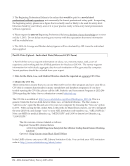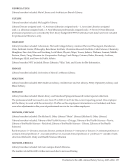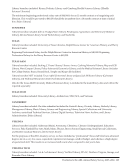Salary Survey Trends 2013–2014 · 9 Salary Survey Trends 2013–2014 Data for 10,168 professional staff members were reported this year for the 115 ARL university libraries, including their law and medical libraries (907 staff members reported by 72 medical libraries and 761 staff members reported by 77 law libraries). For the 10 nonuniversity ARL members, data were reported for 3,791 professional staff members. The tables are organized in seven major sections. The first section includes Tables 1 through 4, which report salary figures for all professionals working in ARL member libraries, including law and medical library data. The second section includes salary information for the 10 nonuniversity research libraries of ARL. The third section, entitled “ARL University Libraries,” reports data in Tables 7 through 27 for the “general” library system of the university ARL members, combining US and Canadian data but excluding law and medical data. The fourth section, composed of Tables 28 through 39, reports data on US ARL university library members excluding law and medical data the fifth section, Tables 40–46, reports data on Canadian ARL university libraries excluding law and medical data. The sixth section, (Tables 47–56) and the seventh section (Tables 57–66) report on medical and law libraries, respectively, combining US and Canadian data. The university population is generally treated in three distinct groups: staff in the “general” library system, staff in the university medical libraries, and staff in the university law libraries. Any branch libraries for which data were received, other than law and medical, are included in the “general” category, whether or not those libraries are administratively independent. Footnotes for many institutions provide information on branch inclusion or exclusion. In all tables where data from US and Canadian institutions are combined, Canadian salaries are converted into US dollar equivalents at the rate of 1.0046 Canadian dollars per US dollar.1 Tables 4 and 40 through 46, however, pertain exclusively to staff in Canadian university libraries, so salary data in those tables are expressed in Canadian dollars. Race and Ethnicity There were 1,302 minority professional staff reported in 99 US ARL university libraries, including law and medical libraries.2 Note that the data for minority professionals comes only from the US ARL university libraries following the Equal Employment Opportunity Commission (EEOC) definitions Canadian law prohibits the identification of Canadians by ethnic category. Currently, 14.6% of the professional staff in US ARL university libraries (including law and medical libraries) belong to one of the four non-Caucasian categories for which ARL keeps records. The percentage of minorities in managerial or leadership positions in ARL academic libraries is far lower: 8% are directors (9 out of 113), 7.7% are associate directors (25 out of 324), 7.2% are assistant directors (11 out of 153) and 9.5% (36 out of 379) are the head of a branch library (see Table 31). Figure 1, below, depicts the overall racial/ethnic distribution of professional staff in US ARL university libraries: Caucasian/Other 85.4%, Asian/Pacific Islander 6.9%, Black 4.4%, Hispanic 2.9%, and American Indian/Alaskan Native 0.4%. 1 This is the average monthly noon exchange rate published in the Bank of Canada Review for the period July 2012–June 2013 and is used in converting figures that are shown effective as of 1 July 2013. This information can be accessed at: http://www. bankofcanada.ca/en/rates/exchange.html. 2 Some US institutions offer their librarians the option of not reporting race and ethnicity others forbid the tracking of racial and ethnic classification altogether. See Footnotes.










































































































































































